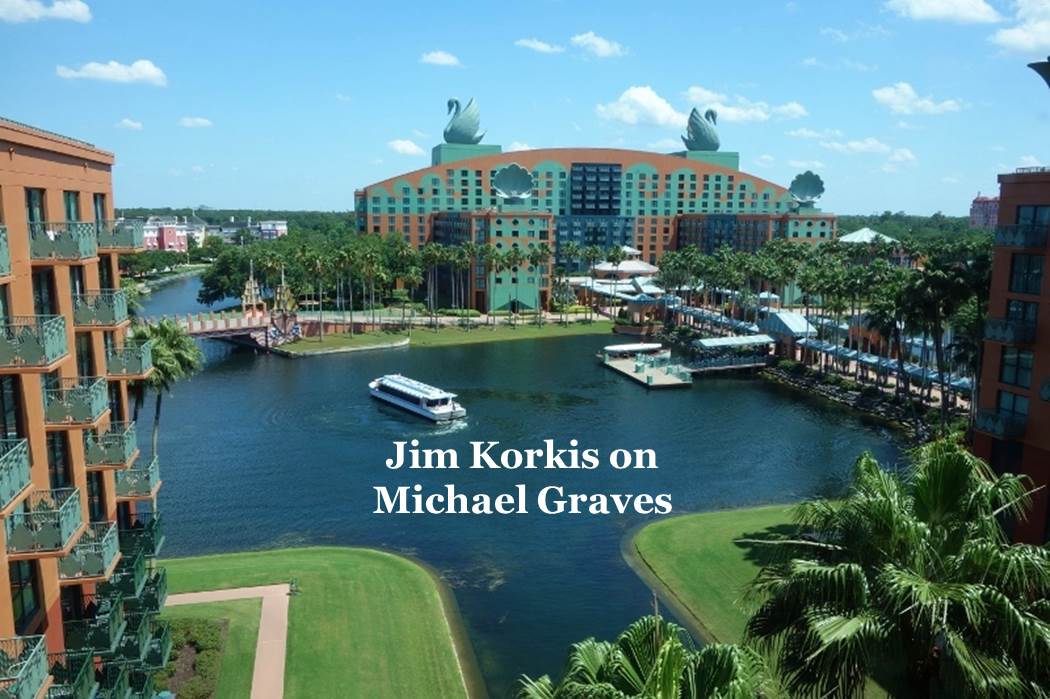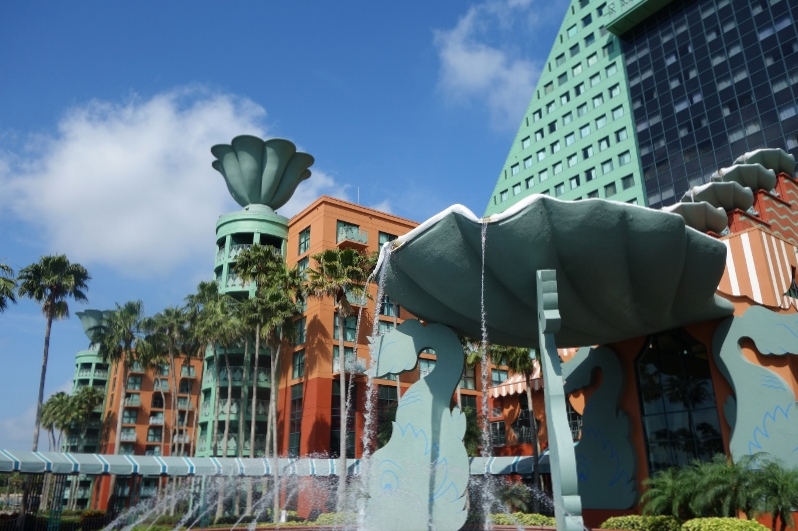A Friday Visit With Jim Korkis: Architect Michael Graves
By Dave Shute
Welcome back to Fridays with Jim Korkis! Jim, the dean of Disney historians and author of Jim’s Gems in The easy Guide, writes about Walt Disney World history every Friday on yourfirstvisit.net.
DISNEY ARCHITECT MICHAEL GRAVES
By Jim Korkis

CEO Michael Eisner once claimed that the two legacies he would leave for Disney theme parks were improved culinary offerings and “entertainment architecture”—the idea that “even the architecture should entertain guests of all ages.”
The first architect that Eisner engaged to produce entertainment architecture was Michael Graves.
The Disney Company had always wanted the Walt Disney World property to be a vacation destination where guests would spend more than just a day or two at the theme park.
So, the company developed other options including water activities from skiing to boating, horseback riding, golf and more. In order to house the guests coming to enjoy these opportunities, the company built three resorts for Disney World’s opening, with plans to immediately build three more, but those plans were delayed by financial factors.
By the time Michael Eisner became Chairman and CEO of the Disney Company in 1984, the company’s connection to innovative themed resorts had faded although the number of guests coming to WDW had greatly increased.
Eisner rejected a plan to build two rather ordinary hotel towers (that he referred to as “refrigerator boxes”) near Epcot.
At this time, Eisner even suggested building a hotel in the shape of Mickey Mouse that would straddle Lake Buena Vista Drive with elevators going up each of Mickey’s legs and cars driving underneath the icon’s crotch.
After some legal wrangling with the Tishman Corporation, Eisner hired the award-winning Princeton architect Michael Graves—who had never designed a hotel before—to design the Walt Disney Swan and Dolphin hotels.
The hotels were intended to accommodate the convention groups who were staying at off-property hotels that had greater convention space than the existing Disney World resorts. When the Swan and Dolphin opened in 1989 and 1990, they offered the largest hotel convention space in the Southeastern United States.
Over the years, the look of the hotels have been the source of much discussion (not all of it flattering). That was intentional, to bring attention to what Eisner described as Disney’s “entertainment architecture” of unusual buildings done by noted architects.
Architect Michael Graves is often described as putting the concept of architectural postmodernism on the map.
His works range from large projects such as buildings to whimsical designs for furniture, teapots, and other household items.
In March 1997, Graves was working on the post office for the city of Celebration that he described as the “smallest building in the city” and was amused that he was responsible for the smallest building and the largest building (The Dolphin hotel) currently on Walt Disney World property.
For his first architectural assignment for the Disney Company, Graves had designed the Team Disney corporate building in Burbank, California.
Graves said when he was in meetings with Michael Eisner, Michael told him: “Look, everyone here will have some design priorities for you but I only have one priority. When I come in to work each morning and go up to my office, I’ll probably have very little to smile about. So do something that will make me smile when I arrive.”
When his first designs for the Team Disney building were rejected, Graves came up with the concept of having the Seven Dwarfs as caryatids. A caryatid is a sculpted figure serving as an architectural support taking the place of a column or a pillar supporting horizontal bands.
This design was “because Snow White and the Seven Dwarfs was truly the foundation of the Disney Studios, and supported the growth of the company just as the dwarfs are supporting the building,” claimed Graves.
* * * * *
Thanks, Jim. Frankly, I find the Swan and Dolphin odd-looking. But I do indeed notice them. I stayed at the Swan in April and the Dolphin in May, and will shortly be publishing updated reviews.
Come back next Friday for more from Jim Korkis!
In the meantime, check out his books, including The Vault of Walt, Who’s Afraid of the Song of the South?, and The Book of Mouse
, and his contributions to The easy Guide to Your First Walt Disney World Visit, all published by Theme Park Press.
MORE DISNEY WORLD HISTORY POSTS FROM JIM KORKIS
- “Summer Magic” on Main Street
- Muppets and Mama Melrose
- Peter Dominick and the Wilderness Lodge
- Dixie Landing and Port Orleans Riverside
- The History of Splash Mountain
- The First Disney World Hotel
- The “Sharing the Magic” Statue
- The First Disney World Monorails
- The Water Park River Country
- The Epcot Fountain
- The Fireplace at the Wilderness Lodge
- Sid Cahuenga at Disney’s Hollywood Studios
- Spaceship Earth
- Downtown Disney
- The Missing Resorts
- Echo Park Homages
- Typhoon Lagoon
Follow yourfirstvisit.net on Facebook or Google+ or Twitter or Pinterest!!





4 comments
Eisner has left a strange legacy behind. Most people dislike what he did and feel that he let the parks wither, which is true. On the other hand, he did open lots of great resorts and restaurants. While I think a more balanced approach would have been better, what he did was not all doom and gloom.
Anthony, I’m not sure that I would agree that someone who opened half the current parks (HS and AK) “let the parks wither.”
As a Disney Resort fanatic, Eisner is a hero to me. His massive increase in hotel rooms on WDW property during the “Disney Decade” was amazing.
I’ve also always been amused by the critics of the Graves’ Swan & Dolphin. They are amazing unique structures. A huge improvement over the previously planned “refrigerator boxes” Eisner referred to.
I especially think the whining about being able to view them from within Epcot is ridiculous. The whole “I felt like I was in France until I saw the Swan or Dolphin argument”. Dumb…….just Dumb.
Thanks, Jeff!!
Leave a Comment | Ask a Question | Note a Problem